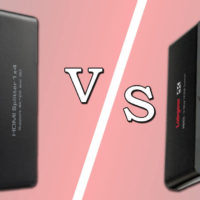Setting up a display structure for any computer gets a bit complicated when you try to use more than one display screen, or try to use a single display screen for multiple devices. This has been a common question among our viewers and we have decided to write this article which clearly explains both the devices and explains the scenarios where you would want one rather than the other.
HDMI Switcher vs Splitter
HDMI Switcher
Just like with an HDMI Splitter, you can physically identify an HDMI switch by observing the number of input and output ports. An HDMI switch will always have a single output port while there can be two or more input ports. An HDMI switch also typically has a button that allows you to cycle through the available input sources.
Just like in the case of the HDMI splitter you can get a clear idea that a switch involves multiple input sources and a single display. The basic assumption for many people in the case of the HDMI switch is usually right, so, let’s discuss what an HDMI switch actually does.
An HDMI switch basically receives multiple input signals but only lets one of those signals pass through the output port. All other signals are suppressed when another signal is being pushed forward. The button lets you cycle through all of the available input sources and choose the one that you want to see at any given time.
For instance, consider a scenario where there is a large TV in your living room and it has a single HDMI input port. You have a cable connection, a Blu-Ray DVD player, and an Xbox all in the same room. The primal way of making this situation work would be to manually unplug the HDMI cable of the current device and then plug the HDMI cable of another device into the display. However, this method is flawed in many ways and can cause a multitude of problems.
Your input port could be damaged due to the wear and tear, it could be that the HDMI port is simply not so easily accessible (happens with some displays when they are wall-mounted), you could be risking stepping over your devices to perform the manual switch. A 3-way HDMI switch will save your life in this situation. All you need to do is plug all of the devices into the HDMI switch’s input and plug its output into the display’s input port.
You can cable-manage your way to make the whole setup look clean and now you won’t have to touch the messy cables again. When you want to play games, you can switch the display to your Xbox, when you want to watch a movie, you can switch it to the Blu-Ray DVD player, and so on. All of this with a single tap of a button, isn’t that cool?
HDMI Splitter
Physically, you can spot a splitter by its number of input and output ports. An HDMI splitter will always have a single HDMI input port and multiple HDMI output ports. This is enough to give you a clear idea that a splitter is used where a single source and more than one display screen are involved. However, your initial assumption might not be accurate.
How does an HDMI splitter work
The name would suggest that this device is used to “split the video signal” into two unique signals that you can then send to two different displays. Generally, you wouldn’t be wrong to assume that this setup will give an extended desktop view with the option to mirror the two screens, which is not the case. The only function of an HDMI splitter is to generate a duplicate of the received signal and send that duplicate to the second screen.
In simpler words, a splitter will only give you a mirror of the main display on the secondary displays. A scenario where a splitter would be perfect is a sports bar. The owner of the bar would usually have 3-4 displays all around the bar and would want to show the same game on all of the screens. This would require the owner to connect the input source to a 4-way HDMI splitter and connect the output HDMI ports to the 4 displays in the bar.
Note that neither of these two devices is going to get you an extended display. An entirely different concept sits at the foundation of extended views and neither an HDMI splitter nor an HDMI switch can achieve that task. There are a few ways you can get extended views, but that is a detailed topic for another article. Make sure that you are clear about what you need before you buy anything because you could easily be wasting over $100 on a device that can’t solve your problem.

